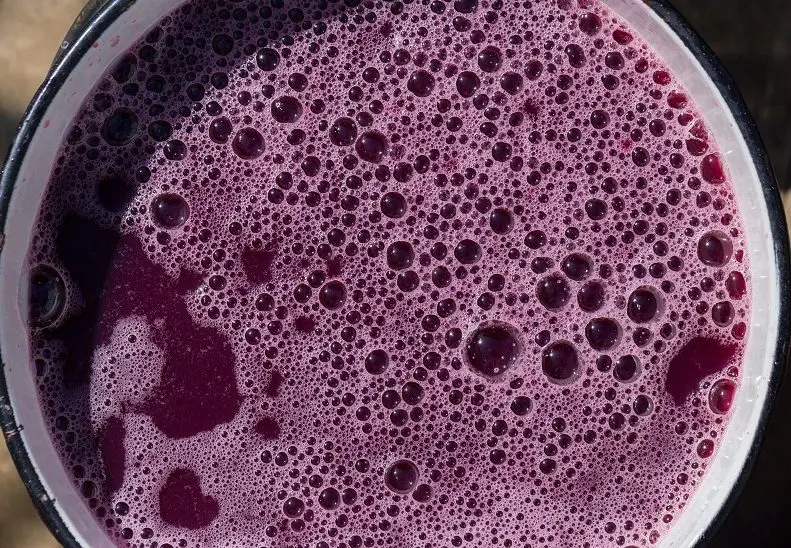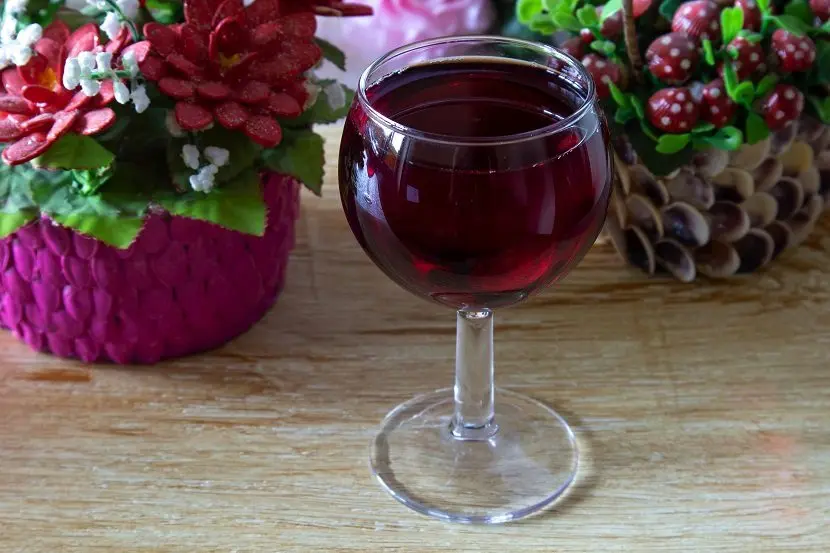In classical winemaking, the pulp separated from the juice is considered waste, thrown away or used to produce distillates – chacha, grappa, etc. But if strong alcohol is not needed, you can make a second wine from pomace at home. Suitable pomace of grapes, apples, currants or any other fruit. Next, we will look at the full technology (called “petio”), which is not much more complicated than the traditional technique, but has several nuances.
Attention! In terms of color, aroma and taste, secondary wine from pulp will be worse than a drink made with pure juice, since most of the coloring matter and other useful elements are separated from the peel and pulp along with the juice during the first pressing. In extreme cases, the resulting “watery” wine can always be distilled into moonshine.
Theory
After separation of the juice, some part of the sugar (1-5%) and extractives remain in the pulp and skin of the raw material, which you do not want to lose. This problem was taken up by the French winemaker from Burgundy Petio, who in 1854 developed a technique for making re-wine from grape pulp, which is applicable to any fruit.
The essence of the method is the equivalent replacement of the squeezed juice with 20% sugar syrup (in the same proportions or close to equal parts). Thanks to the infusion of syrup on the pulp, you can get a drink with a strength of 10-12%. It is interesting that in France this spirit is called “petio” in honor of the author, but they do not recognize it as wine.
Also in the wine-growing regions of France, another low-alcohol drink is made from pomace – “picket”. Not strongly squeezed cake of necessarily sweet, dark grape varieties is simply poured with cold water and put on fermentation. Fortress picket – 1-3%. For most Russian regions, this method is not applicable, since grapes and apples are often sour, and the juice is squeezed out with a press or juicer. Next, we will consider the Petiot method.
Universal recipe for pomace wine
The choice of raw materials. For the preparation of the second wine, the pomace of dark grapes grown in the southern regions is best suited. Try to avoid the Isabella variety, in the skin and pulp of which hydrocyanic acid remains. Wine made from apple pomace or grape pulp of light varieties can turn out to be almost colorless and almost odorless. The same applies to the cake of red currants, cherries, strawberries and raspberries.
When planning to make wine from pomace, during the primary separation of the juice, do not squeeze the pulp dry, leaving at least some of the tannins and trace elements. The pomace should be put on secondary fermentation during the first day (preferably immediately) after separation of the juice in order to prevent oxidation and acetic souring of the pulp. It is very important not to crush the bones, otherwise the drink will turn out bitter.
Regular beet sugar can be replaced with fructose or dextrose (glucose powder). When obtaining syrup, it is important to consider that fructose is 70% sweeter than sugar, and glucose is 30% less sweet. This means that to replace 1 kg of sugar, approximately 590 grams of fructose or 1,45 kg of dextrose are required.
Ingredients:
- fresh cake – 6-7 liters;
- water – 5 liters;
- sugar – 1 kg.
According to the classic recipe, the volume of pomace should be equal to the volume of sugar syrup, but taking into account the Russian realities of not very extractive grapes and other fruits, I advise you to increase the amount of pomace by 20-40%. If the pulp is strongly compressed, the proportions can be equalized.
To avoid infection with mold and other pathogenic microorganisms, all used containers and tools should be washed well, then sterilized with boiling water or steam.
Technology for making second wine
1. Dissolve 80% sugar in water (in our case, 800 grams).
2. Fold the cake into a fermentation container, pour syrup over, mix. It is desirable that 20-30% of the container volume remain free.
3. Install a water seal on the neck of the container (you can use a glove with a hole pierced by a needle in the finger).

4. Transfer the wort to a dark room with a stable temperature of 18-28°C. Every 12 hours, remove the water seal (short-term access of air will not hurt) and mix the wort with a clean hand or a wooden stick, drowning the floating pulp and peel in the juice.
After a maximum of a day, foam should appear on the surface and hiss, which means that fermentation is proceeding normally. If there is no fermentation, you need to add wine yeast or sourdough. During the preparation of the starter, keep the wort under a water lock.

5. After 12-15 days, when the pulp becomes colorless, strain the wort through cheesecloth and squeeze well. Add the remaining sugar to pure juice (according to the proportions in the recipe 200 grams) and pour it into a washed fermentation container again.
6. The total fermentation time of homemade pomace wine (from the moment the preparation was started) is 20-50 days. The end of the process is indicated by the absence of bubbles from the water seal for 1-2 days (the glove was blown away) and a layer of sediment at the bottom.
It’s time to drain the young wine through a straw into another container. Taste the drink, optionally sweeten it with sugar to taste and (or) fix it with vodka (alcohol) in an amount of 2-15% of the volume of wine. Fixing promotes storage, but the taste is tougher.
7. Fill aging containers with wine from the pulp (preferably fill up to the neck to minimize contact with oxygen). Close hermetically (if sugar was added at the previous stage, keep it under a water seal for the first 7-10 days in case of repeated fermentation), then transfer the drink for maturation to a dark room with a temperature of 5-16 ° C – cellar, basement or refrigerator. Leave for at least 3 months (preferably 6-8).
8. First, once every 10 days, then less often, when a 3-4 cm layer of sediment appears, filter the drink by pouring it through a tube into another container, without touching the sediment.
9. If the sediment does not appear in large quantities, the finished pomace wine can be bottled and then hermetically sealed. Fortress – 9-12%. Shelf life in the refrigerator and basement up to 2 years.










